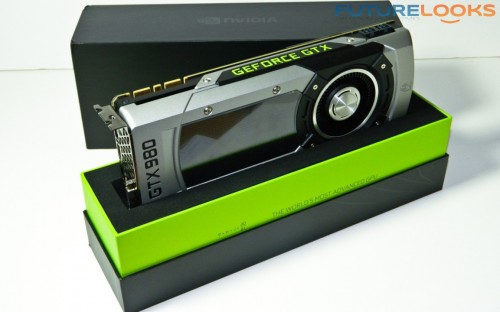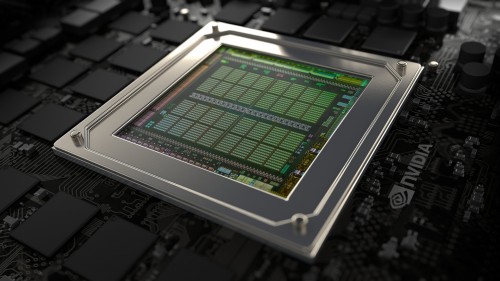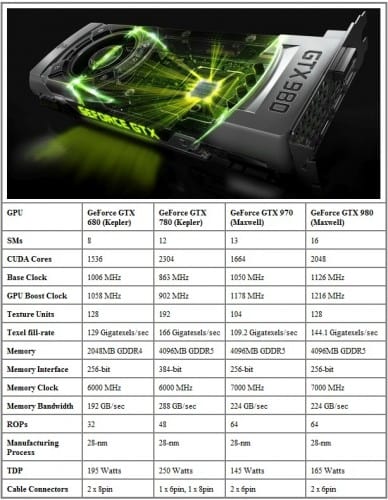On September 18th, NVIDIA launched the brand new GTX 980 and GTX 970 to PC gaming fans at their GAME24 event. The very next day, GPUS from both ASUS and ZOTAC (and more) hit the shelves. Even system builders like iBUYPOWER were ready with stock on hand to build your latest GTX 900 series system. And now we’ve got one too and we’re running NVIDIA’s latest GTX 980 through its paces.
Yes, the NVIDIA’s new GPU is based on the Maxwell GPU architecture, but it’s definitely been beefed up over the first generation Maxwell that came in the GTX 750 Ti. While the first generation created a sub $150 US video card with great performance, it was optimized for mainly 1080p gaming at reasonable settings. But with highly tessellated games like Crysis 3, Metro Last Light, and various Assassin’s Creed titles, it was a big challenge for the GPU, and of course 4K was simply out of the question unless it’s just standard desktop use.
As with every new generation of graphics architecture, the goal of the NVIDIA GeForce GTX 980 video card, is to replace the generation before it with even better performance, and sometimes at a better price. Let’s see how the new GTX 980 does against its predecessors, and against the latest games!
Architectural Features and Specifications
After studying all that the GM204 Maxwell GPU offers, it’s poised to be an impressive leap in terms of architecture and features compared to Kepler, which is very surprising as it doesn’t seem like Kepler could ever be replaced. Lets go down the list of the most important features.
Core Enhancements – The new flagship Maxwell GPUs get bumps and refinements in all of their resources in preparation of the impending launch of DirectX 12 games coming in the next year. Memory is increased to 4 GB stock and a frequency boost to 7 GHz. Coupled with a 256-bit memory bit interface, bandwidth reaches 224 GB/sec. The 980 also receives 64 ROP pixel pipelines over the 780’s lesser 48 which can noticeably improve 3D performance. And, finally, one of Maxwell’s most overlooked features includes refinements made to improving CUDA core efficiency which is one reason why the GTX 750 Ti outperforms some the last two generation’s more powerful cards.
Efficiency – Despite these core improvements, Maxwell is far more efficient than ever consuming less power but able to do more. How you ask? Maxwell’s Streaming Multiprocessors have been re-optimized so that the CUDA Cores are utilized more often to increase graphic performance and more impressively save power. Additionally, the GTX 980 consumes a mere 165 Watts at full load and the GTX 970 needs only 145 Watts. Keep in mind that the GTX 780 needed 250 Watts at max load. That alone should save enthusiasts important money as you won’t need a more expensive high wattage PSU to support two cards. In fact, a good quality 80Plus Gold 650 Watt will easily do 2-way SLI.
Video Memory and Cache Efficiency – The last two hardware enhancements worth mentioning are that the GPU comes with stock 4GB GDDR5 VRAM operating at a mind boggling 7000 MHz (7 GHz) and the L2 cache has been increased to 2MB which is four times larger than Kepler. That may seem unimportant. However, if you recall Intel’s jump to Ivy Bridge, the CPU utilizes its L2 cache so efficiently that the CPU doesn’t need to access RAM as often. Similarly, Maxwel utilizes its own internal L2 cache more often than going to the GDDR5 memory for data resulting in a performance increase. Never underestimate the cache!
NVIDIA GeForce GTX 980 (and GTX 970) Pricing
We think the best part though will be the price. At under $599 US (and under $399 US for the GTX 970), NVIDIA has given gamers, something new to drool over. Traditionally, things that in “60” and a “Ti” become the sweetspot gamer card, so we can’t wait to see what a GTX 960 Ti will have to offer. But for now, let’s continue with our look at the GTX 980!
Graphics Sampling Features
What kinds of graphic enhancements improve the gaming experience? For starters, Multi-Framed Sampling combined with AA sampling offer higher quality anti-aliasing settings with less performance cost. In other words, the extra ROPs lower the performance cost of 4xMSAA quality to the same cost as 2xMSAA settings. Ultimately, the GeForce GTX 980 is great for 2560×1600 gaming with maximum graphics settings and high levels of enabled AA sampling.
Note: Features can be enabled in the NVIDIA Control Panel or in some games. We noticed FXAA was a little brighter and contrasted better than 4xMSAA. The same was apparent in DSR over SR. Results are more noticeable on good quality monitors.
Lighting has always been a challenge in all games. This time, Maxwell uses accelerated NVIDIA VXGI (Voxel Global Illumination) technology to improve and speed up GI. VXGI uses Voxel grids and cone tracing techniques to render global illumination including ambient occlusion in real time. Essentially, lighting is more realistic, explosive light effects stand out better, dynamic lighting gets cleaned up, and there’s less of a performance hit creating those amazing effects. (Entertaining real world rendering can be watched here.)
Notes: Features can be enabled in the NVIDIA Control Panel or in some games. We noticed DSR contrasts lighting and shadows more dynamically. Again, results are more noticeable on good quality monitors.
For the HD enthusiasts, Dynamic Super Resolution (DSR) creates a crisper quality image at higher resolutions by rendering the game at higher resolution and then scaling it down to the user’s native resolution to create nearly 4K quality. However, for enthusiasts who want to game at even higher resolutions like 4K, NVIDIA recommends two GeForce GTX 980 cards running in SLI for the best gaming experience. Otherwise, we’ve found 2K gaming to be an epic quality-performance standard thus far.
Additionally, VR Direct Technology offers support for VR headsets like the Oculus Rift. Originally, the standard latency was around 50 ms to render to the headset. Nvidia managed to achieve 40 ms working with MFAA sampling to achieve even less. Asynchronous Warp takes it a bit further by updating the previous frame rather than rendering a whole new one. In terms of SLI, frames are no longer alternately rendered by the cards. Instead, VR SLI separates each left and right frame locked to one card at a time.
And, of course, we know that Maxwell 100% supports new G-Sync monitors. Those new monitors are arriving in the next few weeks. We recently talked to BenQ at PAX Prime 2014 who have the resources and capabilities to create extremely intuitive G-Sync monitors. Several of the monitors we previewed have on-the-fly 2K, 4K, and G-Sync settings. Functions are built in to the monitor and others come with an external puck that allows full dial control of all the aspects. Plus, their monitors support both AMD or NVIDIA GPU simply by changing a setting. Very impressive!
Test System and Setup
In order to push the GPU to the limit, we’re using an an Intel X99 based system, but expect a look at performance on the Z97 in a later article. All the drivers are the latest we can find from all the manufacturers at the time of writing. Here’s what our load out looks like…
- Processor: Intel Core i7-5960X Haswell-E
- Motherboard: GIGABYTE GA-X99-UD4 (F8)
- Memory: Kingston HyperX 16GB 3000 MHz DDR4
- Graphics 1: NVIDIA GeForce GTX 980 Maxwell (as tested)
- Graphics 2: NVIDIA GeForce GTX 780 Kepler
- Graphics 3: NVIDIA GeForce GTX 680 Kepler
- Storage: Kingston HyperX 3K 240GB SSD
- Power: be quiet! DarkPower Pro 850 Gold PSU
- Cooling: be quiet! DarkRock Pro 3
- OS: Windows 7 Pro
- Display: ASUS VH278HE
At launch 344.07 GeForce WHQL driver were installed to test performance. 3D tests were conducted using maximum settings at a resolution of 1920 x 1080p (ASUS VH278HE). Let’s get on with testing!
Performance Results
As I mentioned, some of the games we have don’t offer every sampling feature and many of the older video cards don’t support or easily support them. The list above makes a bit more sense. When possible in testing, we enable the ones available as they’re part of the new GPU’s features. If your monitor doesn’t support 4K, then DSR can help spice up the graphics a bit. We opted not to push anything outside standard boundaries.
Synthetic Benchmarks
Starting things off with synthetic benchmarks, we put the cards up to tests with two of the more popular benchmarks that anyone can download and run on their own: 3DMark 11 and Unigen Heaven Demo.
3DMark 11
Standard Performance scores say a lot about the GPU regardless of any CUDA core counts and other resources that favor something like a Titan. This is a good indicator of how the efficiency favors Maxwell.
Unigine Heaven
After running the benchmark many times, the GTX 980 managed 108 FPS in the demo. That’s very impressive against the GTX 780’s lower 88 FPS. The GTX 780 Ti closes the gap a bit more at 97 FPS.
Gaming Benchmarks
With the synthetic benches out of the way, let’s get to the more fun stuff, and exactly what NVIDIA makes their GeForce cards for: Gaming!
Crysis 3
It’s been a smooth adventure cranking everything up on this older, but still ferociously punishing title (with an uncertain future). The minimum frame count I noticed was about 53 frames. There’s a great deal of wave, chopper, and gun play action going on in the recorded benchmark so your results may be higher, depending on how smooth your route through the game is. But we chose to take a harder route, and you can clearly see, the GTX 980 stepping up with a very playable frame rate.
Metro: Last Light
Maxwell handles this graphically intensive title brilliantly. It’s a great experience when you can see all that the game has to offer, while being able to successfully play it very smoothly.
Battlefield 4
This was a pleasant surprise. Maxwell scoffs at Battlefield 4 even with insanely detailed settings. Suck it Battlefield 4!
We’ve just got a couple more benchmarks so, so let’s have a look at those and take it on home with some overclocking remarks and our thoughts on NVIDIA’s latest GPU!
Gaming Benchmarks Continued
Splinter Cell
Again, it’s smooth intense action here under my crazy outdoor, search light, gun play chaotic benchmark. This is a pretty game to experience, and even better when maxed out. Especially with playable frame rates.
Far Cry 3
Despite the very detailed Far Cry 3 title, the graphics are smooth and quite nice on the eyes. It’s even better when you can see far off details more clearly. Either way, it’s no problem for the GTX 980.
Temperature, Power Consumption, and Overclocking
Although reference cards do overclock, we try not to push them too far. The reason is due to the smaller GPU coolers commonly found on them. If you want your GPU to last, NVIDIA partners tend to use cooling solutions intended to add cooling and overclocking performance. We’ve been especially impressed by some of the solutions from ZOTAC at launch, as they make a more serious effort to capture market share. We expect to see even more insane solutions down the road.
At any rate, we recorded temps and overclocked the card using auto fan control inside a Thermaltake T81 Urban enclosure. MSI Afterburner, ASUS GPU Tweak, and EVGA Precision are three possible software utilities you can use to overclock your NVIDIA based video card. Despite UI differences, they do roughly the same thing.
At stock, the GTX 980 idled at 14C when the display and system go dormant and reached 42C at desktop with no audible fan noise. Under intense 3D benchmarks, the GPU heated up to 63C with a mere 19 dB fan noise.
When overclocked using Precision X (v16) to 1367 MHz adding about 43 millivolts with a limited 80C max operating temp, but the card doesn’t seem to be anymore audible inside our test rig. The memory topped out at 7.8 GHz which is at least something. We suspect we’re on the edge of oblivion with GDDR5. The performance gains on Metro Last Light and Crysis were about 8 frames in reality so pushing hard seems to only give benchmark bragging rights.
What about power consumption? The test system didn’t top 450 watts during gaming. In fact, the card didn’t seem to want more than 160 Watts playing the more intensive DX11 titles.
Final Thoughts
NVIDIA has this habit of surprising and delighting its community of users. And when they know they have a winner, they tend to make a deal out of it. And their GAME24 event, clearly showed, they had something special in store for their community of fans and gamers. With the launch of the GTX 980 and GTX 970, AMD is definitely on notice in a big way, both in terms of performance and price.
The NVIDIA GeForce GTX 980 fulfills the need for higher frame rates, surprisingly lower power consumption, and an overall higher graphics quality thanks to next generation technologies. It’s also very low noise thanks to a more efficient GPU, which has already seen some impressive third party cooling solutions. But more than anything, $599 US buys you a lot of GPU. And from what we’ve seen thus far, the $399 GTX 970 isn’t far behind it at all, and we’ll be looking at that closely as cards with non-reference coolers hit the shelves.
When we consider Maxwell’s extra graphics features like VXGI lighting, Multi-Frame Sampling, Dynamic Super Resolution, and performance, we see there has been real innovation at NVIDIA improving what we consumers spend our hard earned money on – an amazing user experience. It’s safe to say that there is a lot of head room in Maxwell and we look forward to seeing titles that take full advantage of it. And we can’t wait to see how much further we can push partner solutions and their beefed up coolers.
We congratulate NVIDIA on their newest GPU architecture, and how far they’ve taken it from GTX 750 Ti. With so much going for it, and so much excitement by the community, and even jaded reviewers, we’re happy to throw our Editor’s Choice on it. If you have $599 US (probably a bit less) to spend on the best gaming experience out there, the GTX 980 is it!
Pros
- Impressive performance and features
- Energy efficient and cool running
- Still much to explore with the Maxwell architecture
- VXGI, Multi-Frame Sampling, DSR, and TXAA graphic goodness
- Priced lower than the original GTX 780 at launch (but much faster!)
Cons
- We only got one to test!
Overall Rating: 9.5 / 10.0
Help Us Improve Our Reviews By Leaving a Comment Below!



